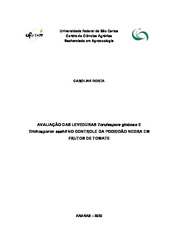| dc.contributor.author | Dorta, Caroline | |
| dc.date.accessioned | 2021-01-10T23:50:52Z | eng |
| dc.date.available | 2021-01-10T23:50:52Z | eng |
| dc.date.issued | 2020-12-10 | eng |
| dc.identifier.citation | DORTA, Caroline. Avaliação das leveduras Torulaspora globosa e Trichosporon asahii no controle da podridão negra em frutos de tomate. 2020. Trabalho de Conclusão de Curso (Graduação em Agroecologia) – Universidade Federal de São Carlos, Araras, 2020. Disponível em: https://repositorio.ufscar.br/handle/ufscar/13651. | * |
| dc.identifier.uri | https://repositorio.ufscar.br/handle/ufscar/13651 | por |
| dc.description.abstract | Post-harvest rot has been responsible for losses by producers, a fact
which has limited the commercialization of agricultural products for consumption in natura,
fruits and vegetables. The fungus Alternaria alternata is the cause of black rot in
post-harvest tomatoes; its control is carried out with fungicides, which contributes to
the need for alternatives that present less risk to human health. In that
context, yeasts have been studied as biological control agents in
fruits. Considering the above, the objective of this research was to determine the potential
of the yeasts Trichosporon asahii (3S44) and Torulaspora globosa (5S55) in the control
of the fungus A. alternata in tomato fruits. The production of organic compounds
volatile (VOCs) was evaluated using closed containers with the inoculated fruit
with A. alternata spores, uncovered Petri dishes inoculated with T cells.
asahii or T. globosa, and a gauze moistened with sterile distilled water. To the
evaluation of yeast survival in the fruit wound, formulations with T. asahii
or T.globosa and Tween 80 vehicles, saline, corn starch, colorless gelatin
and sodium alginate were inoculated into the tomato wounds, and after 48 hours
the portion of the injured region for dilution and plating. The control of the fungus by
yeast in the fruit was evaluated by inoculating T. globosa cells in the wounds, and after
3 hours, spores of A. alternata. After 7 days, evaluations of the
outer and inner diameter and qualitative assessments. As a result, it was observed in the
test of volatile compounds the internal control of the progress of rot in the treatment
with T. globosa and decreased spore production in the presence of T. asahii. O
corn starch and the yeast Torulaspora globosa showed the best
survival results of yeast in the fruit. In the in vivo test of fungus control,
the treatment with the yeast T. globosa differed statistically from the control treatment
both in relation to external and internal symptom, in addition to decreased production
of mycelium. Therefore, the observed results showed that the yeast T. globosa
has the potential to control the Alternaria alternata fungus in tomato fruits. | eng |
| dc.description.sponsorship | Fundação de Amparo à Pesquisa do Estado de São Paulo (FAPESP) | por |
| dc.language.iso | por | por |
| dc.publisher | Universidade Federal de São Carlos | por |
| dc.rights | Attribution-NonCommercial-NoDerivs 3.0 Brazil | * |
| dc.rights.uri | http://creativecommons.org/licenses/by-nc-nd/3.0/br/ | * |
| dc.subject | Controle fúngico | por |
| dc.subject | Formulações de inoculantes | por |
| dc.subject | Leveduras rizosféricas | por |
| dc.subject | Pós-colheita | por |
| dc.title | Avaliação das leveduras Torulaspora globosa e Trichosporon asahii no controle da podridão negra em frutos de tomate | por |
| dc.title.alternative | Evaluation of the yeasts Torulaspora globosa and Trichosporon asahii in the control of black rot in tomato fruits | eng |
| dc.type | TCC | por |
| dc.contributor.advisor1 | Rosa Magri, Márcia Maria | |
| dc.contributor.advisor1Lattes | http://lattes.cnpq.br/4166319985147604 | por |
| dc.description.resumo | As podridões pós-colheita têm sido responsáveis por perdas pelos produtores, fato
que tem limitado a comercialização de produtos agrícolas de consumo in natura, como
frutas e vegetais. O fungo Alternaria alternata é o causador da podridão negra em
tomate na pós-colheita; seu controle é realizado com fungicidas, o que contribui para
a necessidade de alternativas que apresentem menor risco à saúde humana. Nesse
contexto, as leveduras vêm sendo estudadas como agentes de controle biológico em
frutos. Considerando o exposto, o objetivo desta pesquisa foi determinar o potencial
das leveduras Trichosporon asahii (3S44) e Torulaspora globosa (5S55) no controle
do fungo A. alternata em frutos de tomate. A produção de compostos orgânicos
voláteis (COVs) foi avaliada com o uso de recipientes fechados com o fruto inoculado
com esporos de A. alternata, placas de Petri sem tampa inoculadas com células de T.
asahii ou T. globosa, e uma gaze umedecida em água destilada estéril. Para a
avaliação da sobrevivência das leveduras na ferida do fruto, formulações com T. asahii
ou T.globosa e os veículos Tween 80, solução salina, amido de milho, gelatina incolor
e alginato de sódio foram inoculadas nas feridas do tomate, e após 48 horas retirouse
a porção da região ferida para diluição e plaqueamento. O controle do fungo pela
levedura no fruto foi avaliado inoculando-se células de T. globosa nas feridas, e após
3 horas, esporos de A. alternata. Depois de 7 dias foram realizadas avaliações do
diâmetro externo e interno e avaliações qualitativas. Como resultado foi observado no
teste de compostos voláteis o controle interno do avanço da podridão no tratamento
com a T. globosa e diminuição da produção de esporos na presença da T. asahii. O
amido de milho e a levedura Torulaspora globosa apresentaram os melhores
resultados de sobrevivência da levedura no fruto. No teste in vivo do controle do fungo,
o tratamento com a levedura T. globosa diferiu estatisticamente do tratamento controle
tanto em relação ao sintoma externo quanto interno, além da diminuição da produção
de micélio. Portanto, os resultados observados mostraram que a levedura T. globosa
apresenta potencial para controle do fungo Alternaria alternata em frutos de tomate. | por |
| dc.publisher.initials | UFSCar | por |
| dc.subject.cnpq | CIENCIAS AGRARIAS::AGRONOMIA::FITOSSANIDADE | por |
| dc.description.sponsorshipId | 2019/04843-9 | por |
| dc.publisher.address | Câmpus Araras | por |
| dc.contributor.authorlattes | http://lattes.cnpq.br/1315166264090327 | por |
| dc.publisher.course | Agroecologia - Ae-Ar | por |

